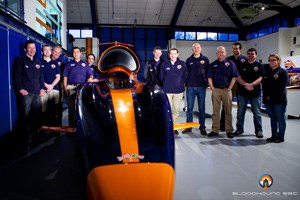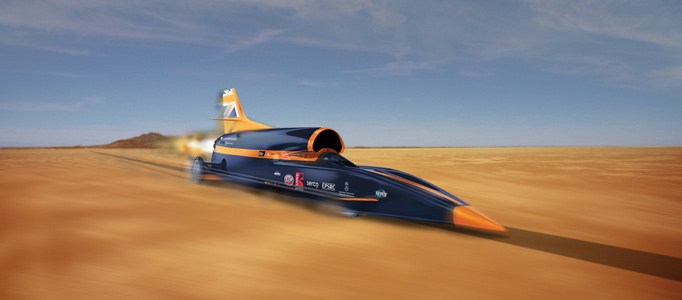The Bloodhound SSC – Image courtesy of Curventa and Siemens
It’s faster than any Bugatti, Porsche, or Ferrari. It’s faster than many aircraft. In fact, it’s faster than a bullet.
Yet Britain’s quickest ever car doesn’t look like any supercar you can buy. It is a strange pencil-shaped vehicle that is mostly kept in shed near Bristol docks.
But with a 1000mph top speed, the Bloodhound SSC could easily over-take any of the world’s most expensive sports cars. And 2013 is the year in which it could make history.
The rocket-and-jet-powered car is currently in the final stages of preparation for the drive of its life this summer.
The Bloodhound will take to a dry lake track in South Africa in an attempt to break the World Land Speed Record. The engineers running the Bloodhound project also plan for it to become the first car to record the magical speedometer figure of 1000mph.
The UK’s most supersonic supercar will aim not only to beat any previous wheeled vehicle’s speed – but to thrash it. If Bloodhound achieves 1000mph it will be 33% faster than any car before and make the biggest leap in land speed records ever.
The colourful Scottish engineer leading the Bloodhound team is Richard Noble, who along with his high-speed driver RAF Wing Commander Andy Green, has held the world land speed record for the last 30 years.
Past Glories

The engineering team – Image courtesy of Curventa and Siemens, photo credit Stephan Marjoram.
Noble’s Thrust 2 reached 633mph in the Nevada desert in 1983, then Thrust SSC hit 763mph in Jordan in 1997. This year Bloodhound will try to pass that record by a further 240mph.
Bloodhound engineers tackled the engineering obstacles with admirable British ingenuity. The initial acceleration comes from a ferocious boost from a Typhoon Eurofighter jet engine. Then at 350mph, a second engine takes over – the largest rocket ever designed or built in the UK.
The enormous power of the rocket and jet engines is the equivalent to the combined power of 180 Formula One cars. In fact, there is a conventional V12 racing car engine on board – but that’s just used as a high-powered fuel pump to feed the 14-foot-long rocket.
Slow Me Down
The biggest problem, however, is how to stop the 6.4-ton Bloodhound. At a speed of mile every 3.5 seconds it can run out of track very quickly. The engineers decided to use a combination of extending flaps to act as air brakes and two very strong chutes that won’t be torn from the car at 1000mph. Green explains: “Once the car is down to about 200 mph (which will take about four miles), I can use more conventional wheel brakes to stop the car in about half a mile – leaving us with a safety margin of one mile… just in case.”
The daunting project appears to be right on course. Volunteers have already started clearing 6,000 tonnes of loose stones from 15-mile test strip at Hakskeen Pan in South Africa’s Northern Cape Province. Bloodhound’s wheels were tested to see how they would cope on the Hakskeen surface in December 2012 and in November a speed trial there was won by a Suzuki Hayabusa motorbike, which achieved 199mph… somewhat short of Bloodhound’s daunting target.





 Facebook
Facebook Twitter
Twitter Instagram
Instagram LinkedIn
LinkedIn Youtube
Youtube